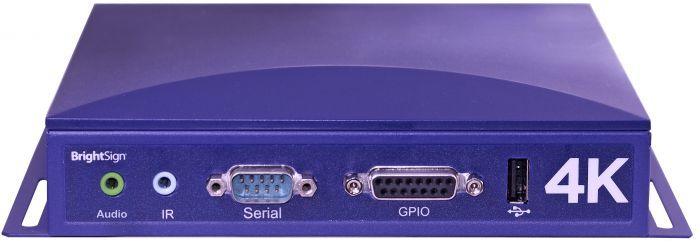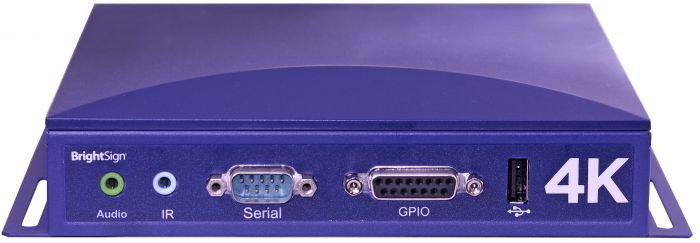
BrightSign’s New 4K Player Makes 4K In Digital Signage Viable
May 23, 2014 by Dave Haynes

I have seen a lot of airports lately and it gets ugly in a week, so I am still noodling whether I will go to InfoComm, or skip it for the first time in forever. If I do go, one of the things I’ll make a bee-line to see is BrightSign’s solid-taste 4K media player.
The company has been talking the unit up for a bit now, but I’ve not had the chance to see its size and, much more to the point, its output.
What really interests me is how it supports the new h.265 video standard. In non-nerd terms, it’s an emerging video compression standard that makes moving around BIG 4K HD video files realistic. Using h.265, distributing a 4K media file consumes roughly the same bandwidth as a 1080P HD video compressed to the industry-default h.2674 standard.
The biggest issues facing 4K adoption were the monster file sizes and the impact on data traffic, which h.265 appears to resolve, and the lack of 4K content (apart from nature and travel pieces). The latter is starting to get resolved, with Netflix streaming House of Cards in 4K and other stuff coming in the pipeline.
But movies and binge-watching series are not what digital signage is about, and it is highly debatable how much of what’s produced for digital signage jobs needs to be in 4K. Ambient, experiential stuff … sure. Menu-boards and sales promotion signs, not really. There’s also the debate as to whether consumers – given that they are moving and often some distance from screens – will even notice or appreciate ultra high def.
BrightSign says its new player is “the first to deliver a true end-to-end 4K solution that accepts H.265 – encoded content and delivers 60 frames per second output via HDMI 2.0.”
“There’s a great deal of excitement and anticipation around 4K, but unfortunately many of the purported 4K solutions currently available fall short and don’t deliver a true 4K experience,” says CEO Jeff Hastings. “However our BrightSign 4K player complies with the new standards to preserve video quality from encoding to output and support the complete 4K ecosystem, start to finish.”
For content to remain 4K native and be delivered at the highest visual quality, BrightSign argues in a press release, video must be captured on a 4K-capable camera, encoded and decoded using the new H.265 compression standard at 10 bits/channel, and fed to the display via HDMI 2.0 to preserve the original 60 fps frame rate. Any broken link in this chain of events adversely impacts video quality and the output falls short of what 4K is made to be.
I can’t find a price on the units, but let’s assume they are just south of $1,000. They start shipping in volume this summer.



Leave a comment